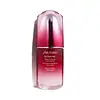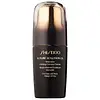What's inside
What's inside
 Key Ingredients
Key Ingredients

 Benefits
Benefits

 Concerns
Concerns

 Ingredients Side-by-side
Ingredients Side-by-side

Water
Skin ConditioningAlcohol Denat.
AntimicrobialGlycerin
HumectantButylene Glycol
HumectantPEG/PPG-17/4 Dimethyl Ether
Skin ConditioningTriethylhexanoin
MaskingCyclohexasiloxane
EmollientDimethicone
EmollientPhenoxyethanol
PreservativeTrehalose
HumectantAmmonium Acryloyldimethyltaurate/Beheneth-25 Methacrylate Crosspolymer
Emulsion StabilisingPEG-14m
Emulsion StabilisingAcrylates/C10-30 Alkyl Acrylate Crosspolymer
Emulsion StabilisingTocopheryl Acetate
AntioxidantPEG/PPG-14/7 Dimethyl Ether
Skin ConditioningRosa Damascena Flower Water
MaskingParfum
MaskingDisodium EDTA
Potassium Hydroxide
BufferingSilica
AbrasiveIsoceteth-10
EmulsifyingLinalool
PerfumingLauryl Betaine
CleansingGinkgo Biloba Leaf Extract
Skin ConditioningGeraniol
PerfumingCitronellol
PerfumingOriganum Majorana Leaf Extract
AntiseborrhoeicNelumbo Nucifera Germ Extract
Skin ConditioningAlcohol
AntimicrobialSodium Carboxymethyl Beta-Glucan
CleansingBHT
AntioxidantThymus Serpyllum Extract
Skin ConditioningPerilla Ocymoides Leaf Extract
TonicSodium Bicarbonate
AbrasiveIris Florentina Root Extract
MaskingSodium Benzoate
MaskingGanoderma Lucidum Stem Extract
Skin ConditioningWater, Alcohol Denat., Glycerin, Butylene Glycol, PEG/PPG-17/4 Dimethyl Ether, Triethylhexanoin, Cyclohexasiloxane, Dimethicone, Phenoxyethanol, Trehalose, Ammonium Acryloyldimethyltaurate/Beheneth-25 Methacrylate Crosspolymer, PEG-14m, Acrylates/C10-30 Alkyl Acrylate Crosspolymer, Tocopheryl Acetate, PEG/PPG-14/7 Dimethyl Ether, Rosa Damascena Flower Water, Parfum, Disodium EDTA, Potassium Hydroxide, Silica, Isoceteth-10, Linalool, Lauryl Betaine, Ginkgo Biloba Leaf Extract, Geraniol, Citronellol, Origanum Majorana Leaf Extract, Nelumbo Nucifera Germ Extract, Alcohol, Sodium Carboxymethyl Beta-Glucan, BHT, Thymus Serpyllum Extract, Perilla Ocymoides Leaf Extract, Sodium Bicarbonate, Iris Florentina Root Extract, Sodium Benzoate, Ganoderma Lucidum Stem Extract
Dimethicone
EmollientDipropylene Glycol
HumectantGlycerin
HumectantBis-PEG-18 Methyl Ether Dimethyl Silane
EmollientPEG-75
HumectantDiphenylsiloxy Phenyl Trimethicone
Skin ConditioningBis-Diglyceryl Polyacyladipate-2
EmollientPiperidinepropionic Acid
Skin ConditioningTrimethylsiloxysilicate
EmollientPolysilicone-11
Polysorbate 20
EmulsifyingPEG-10 Dimethicone
Skin ConditioningPentaerythrityl Tetraethylhexanoate
EmollientPhenoxyethanol
PreservativeSodium Acrylate/Sodium Acryloyldimethyl Taurate Copolymer
Emulsion StabilisingPEG-60 Glyceryl Isostearate
Butylene Glycol
HumectantIsostearic Acid
CleansingIsohexadecane
EmollientSodium Citrate
BufferingSuccinoglycan
Skin ConditioningAcrylates/C10-30 Alkyl Acrylate Crosspolymer
Emulsion StabilisingTocopheryl Acetate
AntioxidantSodium Hyaluronate
HumectantParfum
MaskingPolysorbate 80
EmulsifyingPotassium Hydroxide
BufferingLauryl Betaine
CleansingBHT
Antioxidant2-O-Ethyl Ascorbic Acid
Skin ConditioningXanthan Gum
EmulsifyingCitric Acid
BufferingSodium Metabisulfite
AntioxidantDisodium EDTA
Sorbitan Oleate
EmulsifyingSodium Metaphosphate
BufferingAlcohol
AntimicrobialLinalool
PerfumingGlycyrrhiza Glabra Root Extract
BleachingButylphenyl Methylpropional
PerfumingLimonene
PerfumingCI 77492
Cosmetic ColorantAlpha-Isomethyl Ionone
PerfumingPrunus Speciosa Leaf Extract
Skin ConditioningCitronellol
PerfumingGeraniol
PerfumingBenzyl Benzoate
AntimicrobialAngelica Acutiloba Root Extract
Skin ConditioningRubus Suavissimus Leaf Extract
Skin ConditioningIsodonis Japonicus Leaf/Stalk Extract
MaskingCI 77491
Cosmetic ColorantHibiscus Esculentus Fruit Extract
Skin ConditioningCamellia Sinensis Leaf Extract
AntimicrobialTocopherol
AntioxidantSodium Benzoate
MaskingDimethicone, Dipropylene Glycol, Glycerin, Bis-PEG-18 Methyl Ether Dimethyl Silane, PEG-75, Diphenylsiloxy Phenyl Trimethicone, Bis-Diglyceryl Polyacyladipate-2, Piperidinepropionic Acid, Trimethylsiloxysilicate, Polysilicone-11, Polysorbate 20, PEG-10 Dimethicone, Pentaerythrityl Tetraethylhexanoate, Phenoxyethanol, Sodium Acrylate/Sodium Acryloyldimethyl Taurate Copolymer, PEG-60 Glyceryl Isostearate, Butylene Glycol, Isostearic Acid, Isohexadecane, Sodium Citrate, Succinoglycan, Acrylates/C10-30 Alkyl Acrylate Crosspolymer, Tocopheryl Acetate, Sodium Hyaluronate, Parfum, Polysorbate 80, Potassium Hydroxide, Lauryl Betaine, BHT, 2-O-Ethyl Ascorbic Acid, Xanthan Gum, Citric Acid, Sodium Metabisulfite, Disodium EDTA, Sorbitan Oleate, Sodium Metaphosphate, Alcohol, Linalool, Glycyrrhiza Glabra Root Extract, Butylphenyl Methylpropional, Limonene, CI 77492, Alpha-Isomethyl Ionone, Prunus Speciosa Leaf Extract, Citronellol, Geraniol, Benzyl Benzoate, Angelica Acutiloba Root Extract, Rubus Suavissimus Leaf Extract, Isodonis Japonicus Leaf/Stalk Extract, CI 77491, Hibiscus Esculentus Fruit Extract, Camellia Sinensis Leaf Extract, Tocopherol, Sodium Benzoate
 Reviews
Reviews

Ingredients Explained
These ingredients are found in both products.
Ingredients higher up in an ingredient list are typically present in a larger amount.
Acrylates/C10-30 Alkyl Acrylate Crosspolymer is a synthetic polymer. It is used to thicken and improve the texture of products. Due to its properties, it can prevent water and oil ingredients from separating.
Alcohol comes in many different forms. Different types of alcohol will have different effects on skin. This ingredient is usually an astringent alcohol.
These alcohols are drying on the skin. They may strip away your skin's natural oils and even damage your skin barrier. Astringent alcohols may also irritate skin.
Other types of astringent alcohols include:
According to the National Rosacea Society based in the US, you should be mindful of products with these alcohols in the top half of ingredients.
Any type of sanitizing product will have high amounts of alcohol to help kill bacteria and viruses.
Fatty alcohols come from plant oils such as coconut oil. These can help hydrate the skin and are non-irritating. Some fatty alcohols include cetyl and stearyl alcohol.
Learn more about AlcoholBHT is a synthetic antioxidant and preservative.
As an antioxidant, it helps your body fight off free-radicals. Free-radicals are molecules that may damage your skin cells.
As a preservative, it is used to stabilize products and prevent them from degrading. Specifically, BHT prevents degradation from oxidation.
The concerns related to BHT come from oral studies; this ingredient is currently allowed for use by both the FDA and EU.
However, it was recently restricted for use in the UK as of April 2024.
Learn more about BHTButylene Glycol (or BG) is used within cosmetic products for a few different reasons:
Overall, Butylene Glycol is a safe and well-rounded ingredient that works well with other ingredients.
Though this ingredient works well with most skin types, some people with sensitive skin may experience a reaction such as allergic rashes, closed comedones, or itchiness.
Learn more about Butylene GlycolCitronellol is used to add fragrance/parfum to a product. It is often derived from plants such as roses. In fact, it can be found in many essential oils including geranium, lavender, neroli, and more. The scent of Citronellol is often described as "fresh, grassy, and citrus-like".
Since the Citronellol molecule is already unstable, Citronellol becomes irritating on the skin when exposed to air.
Citronellol is a modified terpene. Terpenes are unsaturated hydrocarbons found in plants. They make up the primary part of essential oils.
Citronellol is not able to be absorbed into deeper layers of the skin. It has low permeability,
Citronellol is also a natural insect repellent.
Learn more about CitronellolDimethicone is a type of synthetic silicone created from natural materials such as quartz.
What it does:
Dimethicone comes in different viscosities:
Depending on the viscosity, dimethicone has different properties.
Ingredients lists don't always show which type is used, so we recommend reaching out to the brand if you have questions about the viscosity.
This ingredient is unlikely to cause irritation because it does not get absorbed into skin. However, people with silicone allergies should be careful about using this ingredient.
Note: Dimethicone may contribute to pilling. This is because it is not oil or water soluble, so pilling may occur when layered with products. When mixed with heavy oils in a formula, the outcome is also quite greasy.
Learn more about DimethiconeDisodium EDTA plays a role in making products more stable by aiding other preservatives.
It is a chelating agent, meaning it neutralizes metal ions that may be found in a product.
Disodium EDTA is a salt of edetic acid and is found to be safe in cosmetic ingredients.
Learn more about Disodium EDTAGeraniol is used to add fragrance/parfum to a product. It is the main component of citronellol. It is a monoterpenoid and an alcohol.
Monoterpenes are naturally found in many parts of different plants.
Geraniol can be found in many essential oils including Rose Oil and Citronella Oil. The scent of Geraniol is often described as "rose-like". Many foods also contain Geraniol for fruit flavoring.
Geraniol can irritate the skin when exposed to air. However, irritation depends on the ability of geraniol to penetrate into the skin. In general, geraniol is not able to penetrate skin easily.
Geraniol is colorless and has low water-solubility. However, it is soluble in common organic solvents.
Like citronellol, it is a natural insect repellent.
2,6-Octadien-1-ol, 3,7-dimethyl-, (2E)-
Learn more about GeraniolGlycerin is already naturally found in your skin. It helps moisturize and protect your skin.
A study from 2016 found glycerin to be more effective as a humectant than AHAs and hyaluronic acid.
As a humectant, it helps the skin stay hydrated by pulling moisture to your skin. The low molecular weight of glycerin allows it to pull moisture into the deeper layers of your skin.
Hydrated skin improves your skin barrier; Your skin barrier helps protect against irritants and bacteria.
Glycerin has also been found to have antimicrobial and antiviral properties. Due to these properties, glycerin is often used in wound and burn treatments.
In cosmetics, glycerin is usually derived from plants such as soybean or palm. However, it can also be sourced from animals, such as tallow or animal fat.
This ingredient is organic, colorless, odorless, and non-toxic.
Glycerin is the name for this ingredient in American English. British English uses Glycerol/Glycerine.
Learn more about GlycerinLauryl Betaine is a surfactant. It helps cleanse your skin by gathering oil, dirt, and other pollutants to be rinsed away.
Linalool is a fragrance and helps add scent to products. It's derived from common plants such as cinnamon, mint, citrus, and lavender.
Like Limonene, this ingredient oxidizes when exposed to air. Oxidized linalool can cause allergies and skin sensitivity.
This ingredient has a scent that is floral, spicy tropical, and citrus-like.
Learn more about LinaloolParfum is a catch-all term for an ingredient or more that is used to give a scent to products.
Also called "fragrance", this ingredient can be a blend of hundreds of chemicals or plant oils. This means every product with "fragrance" or "parfum" in the ingredients list is a different mixture.
For instance, Habanolide is a proprietary trade name for a specific aroma chemical. When used as a fragrance ingredient in cosmetics, most aroma chemicals fall under the broad labeling category of “FRAGRANCE” or “PARFUM” according to EU and US regulations.
The term 'parfum' or 'fragrance' is not regulated in many countries. In many cases, it is up to the brand to define this term.
For instance, many brands choose to label themselves as "fragrance-free" because they are not using synthetic fragrances. However, their products may still contain ingredients such as essential oils that are considered a fragrance by INCI standards.
One example is Calendula flower extract. Calendula is an essential oil that still imparts a scent or 'fragrance'.
Depending on the blend, the ingredients in the mixture can cause allergies and sensitivities on the skin. Some ingredients that are known EU allergens include linalool and citronellol.
Parfum can also be used to mask or cover an unpleasant scent.
The bottom line is: not all fragrances/parfum/ingredients are created equally. If you are worried about fragrances, we recommend taking a closer look at an ingredient. And of course, we always recommend speaking with a professional.
Learn more about ParfumPhenoxyethanol is a preservative that has germicide, antimicrobial, and aromatic properties. Studies show that phenoxyethanol can prevent microbial growth. By itself, it has a scent that is similar to that of a rose.
It's often used in formulations along with Caprylyl Glycol to preserve the shelf life of products.
Potassium hydroxide is commonly known as caustic potash. It is used to fix the pH of a product or as a cleaning agent in soap. In cleansers, it is used for the saponification of oils.
Sapnification is the process of creating fatty acid metal salts from triglycerides and a strong base. During this process, Potassium Hydroxide is used up and is not present in the final product.
Using high concentrations of Potassium Hydroxide have shown to irritate the skin.
Learn more about Potassium HydroxideSodium Benzoate is a preservative. It's used in both cosmetic and food products to inhibit the growth of mold and bacteria. It is typically produced synthetically.
Both the US FDA and EU Health Committee have approved the use of sodium benzoate. In the US, levels of 0.1% (of the total product) are allowed.
Sodium benzoate works as a preservative by inhibiting the growth of bacteria inside of cells. It prevents the cell from fermenting a type of sugar using an enzyme called phosphofructokinase.
It is the salt of benzoic acid. Foods containing sodium benzoate include soda, salad dressings, condiments, fruit juices, wines, and snack foods.
Studies for using ascorbic acid and sodium benzoate in cosmetics are lacking, especially in skincare routines with multiple steps.
We always recommend speaking with a professional, such as a dermatologist, if you have any concerns.
Learn more about Sodium BenzoateTocopheryl Acetate is AKA Vitamin E. It is an antioxidant and protects your skin from free radicals. Free radicals damage the skin by breaking down collagen.
One study found using Tocopheryl Acetate with Vitamin C decreased the number of sunburned cells.
Tocopheryl Acetate is commonly found in both skincare and dietary supplements.
Learn more about Tocopheryl Acetate